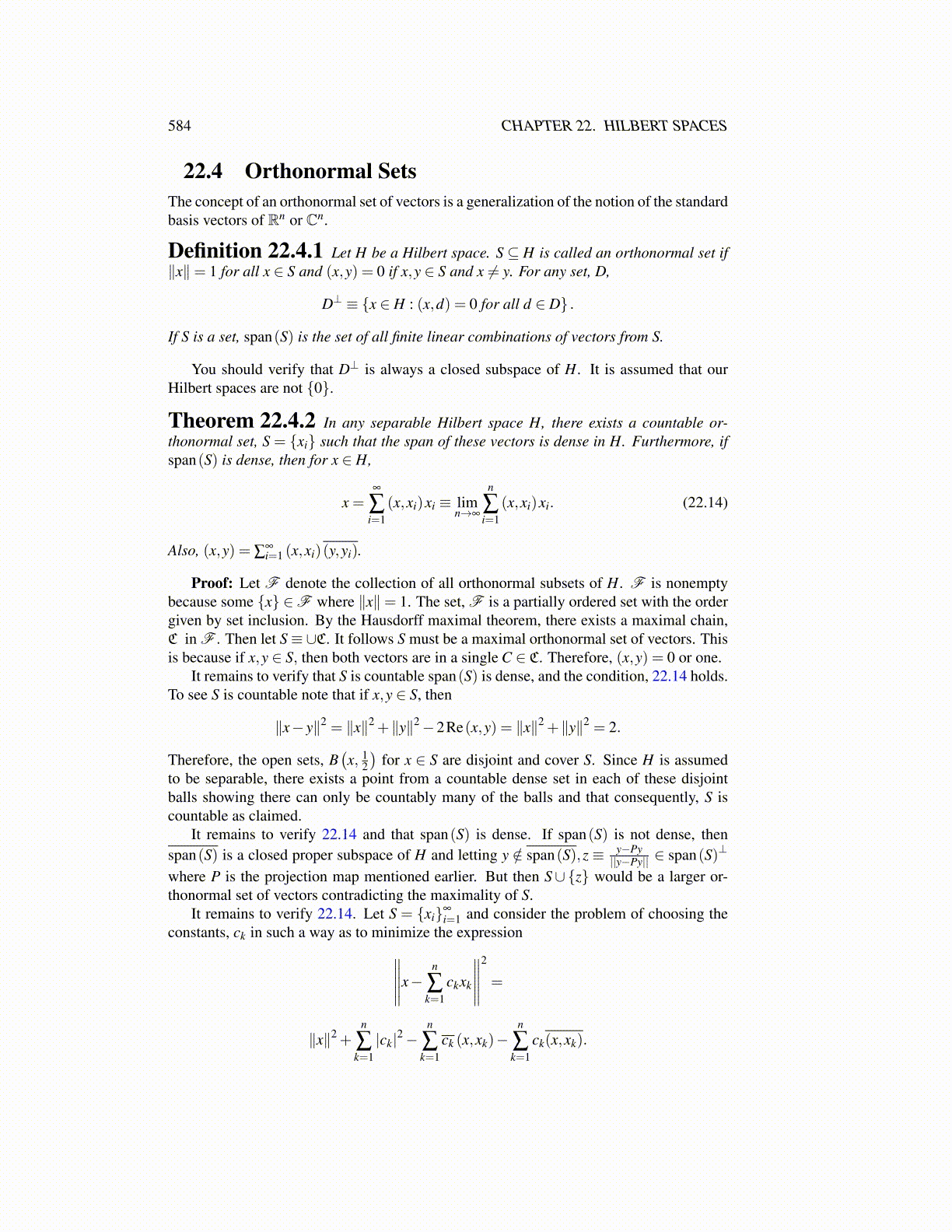
584 CHAPTER 22. HILBERT SPACES
22.4 Orthonormal SetsThe concept of an orthonormal set of vectors is a generalization of the notion of the standardbasis vectors of Rn or Cn.
Definition 22.4.1 Let H be a Hilbert space. S ⊆ H is called an orthonormal set if∥x∥= 1 for all x ∈ S and (x,y) = 0 if x,y ∈ S and x ̸= y. For any set, D,
D⊥ ≡ {x ∈ H : (x,d) = 0 for all d ∈ D} .
If S is a set, span(S) is the set of all finite linear combinations of vectors from S.
You should verify that D⊥ is always a closed subspace of H. It is assumed that ourHilbert spaces are not {0}.
Theorem 22.4.2 In any separable Hilbert space H, there exists a countable or-thonormal set, S = {xi} such that the span of these vectors is dense in H. Furthermore, ifspan(S) is dense, then for x ∈ H,
x =∞
∑i=1
(x,xi)xi ≡ limn→∞
n
∑i=1
(x,xi)xi. (22.14)
Also, (x,y) = ∑∞i=1 (x,xi)(y,yi).
Proof: Let F denote the collection of all orthonormal subsets of H. F is nonemptybecause some {x} ∈F where ∥x∥= 1. The set, F is a partially ordered set with the ordergiven by set inclusion. By the Hausdorff maximal theorem, there exists a maximal chain,C in F . Then let S≡∪C. It follows S must be a maximal orthonormal set of vectors. Thisis because if x,y ∈ S, then both vectors are in a single C ∈ C. Therefore, (x,y) = 0 or one.
It remains to verify that S is countable span(S) is dense, and the condition, 22.14 holds.To see S is countable note that if x,y ∈ S, then
∥x− y∥2 = ∥x∥2 +∥y∥2−2Re(x,y) = ∥x∥2 +∥y∥2 = 2.
Therefore, the open sets, B(x, 1
2
)for x ∈ S are disjoint and cover S. Since H is assumed
to be separable, there exists a point from a countable dense set in each of these disjointballs showing there can only be countably many of the balls and that consequently, S iscountable as claimed.
It remains to verify 22.14 and that span(S) is dense. If span(S) is not dense, thenspan(S) is a closed proper subspace of H and letting y /∈ span(S),z ≡ y−Py
||y−Py|| ∈ span(S)⊥
where P is the projection map mentioned earlier. But then S∪{z} would be a larger or-thonormal set of vectors contradicting the maximality of S.
It remains to verify 22.14. Let S = {xi}∞
i=1 and consider the problem of choosing theconstants, ck in such a way as to minimize the expression∥∥∥∥∥x−
n
∑k=1
ckxk
∥∥∥∥∥2
=
∥x∥2 +n
∑k=1|ck|2−
n
∑k=1
ck (x,xk)−n
∑k=1
ck(x,xk).